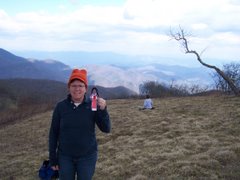Post by Mary Bennett
On
April 3, 2013, the Land Trust for the Little Tennessee River and the Friends of
the Franklin Greenway co-sponsored the Invasive Species Awareness Day along the
Greenway Walking Path beside the Little Tennessee River. Duke Energy provided financial support and
Franklin AT Ambassador, Mary Bennett, was contacted as event coordinator.
Approximately 250 students
in grades 5-12, from 4 educational
institutions (Oconaluftee Job Corps, Macon Early College, Franklin High School
and Mountain View Intermediate School ) participated in outdoor Invasive
Species Awareness Day spring event.
 |
| Invasive Species Awareness Day water quality presentation from WATR – Watershed Association of the Tuckaseegee River. |
Interactive
Educational Presentation Stations hosted by ten professional conservation
organizations, private contractors, from local nonprofits to state and federal
government agencies engaged student groups on a wealth of aspects surrounding
the of issues invasive species. Small
groups of students (about 8-12 per group) rotated through a series of hands- on
learning stations addressing the concerns of invasive species, including plants
and animals, identification, history, and management solutions. Pre-activity information, instructional
materials and web links on “Invasives” were provided to teachers in advance of
event day.
 |
| US Fish & Wildlife rep illustrates clam life cycles to elementary school students |
Each station, presented a
topic unique aspect of invasive species ranging from plants, plant pathogens,
insects, clams, fish, mammals, soil erosion, water quality, animal adaptations,
feral cats and dogs skulls, etc.
Presenters utilized visual aids, natural artifacts, question and answer,
guessing activities and scientific observation and analysis to engage students
in understanding.
 |
| Students study the plant stems of native and non native plants along the Little Tennessee River. |
Two additional
instructional methods were included during the day: Service Learning and Cross
Age Tutoring. The high school students
in Agricultural Education and the Job Corps trainees gained valuable skill
development by assisting in the removal of Kudzu near the edge of the
Greenway. Students learned about the
tools required for the specific job and cleared the area and followed up with
erosion control grass seeding and straw coverage. These young adults provided a community
service to the local community.
The Early College students
developed valuable leadership skills by conducting multiple engaging and highly
interactive activities for the younger school students. The students created hands-on learning
lessons that allowed every child attending a chance to test knowledge of native
versus nonnative species, build a water filter, identify a watershed, a food
web and examine bones, branches and shells.
The interaction of teenagers with “tween agers” enriched the experiential
learning process.






